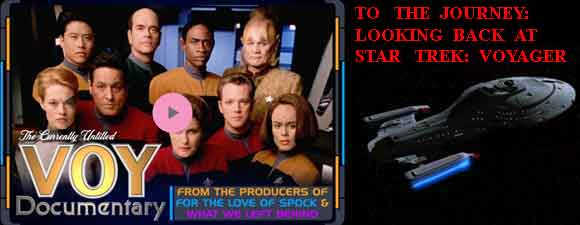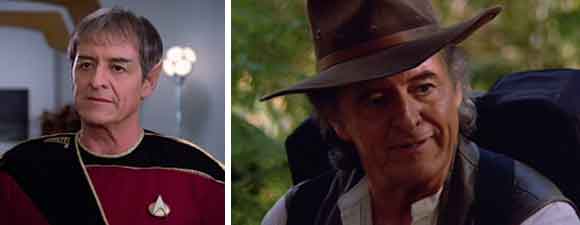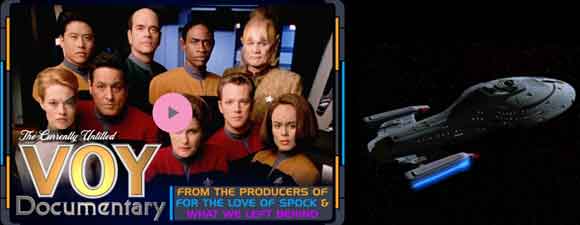Retro Review: Year of Hell
7 min read
yearofhellbanner
A species with the technology to erase entire populations from time pulls Voyager into a deadly conflict.
Plot Summary: A Krenim ship eradicates all life from the planet of a culture with whom they are at war. But because certain outposts of the Krenim Imperium are not restored by this attack, the commander decides that they must wipe every single member of their adversary’s species from time. Meanwhile, on Voyager, the crew inaugurates a new astrometrics lab fitted with sensors designed by Seven and Kim, whose more accurate charting promises to cut five years off of the crew’s journey home. Janeway has created an alliance with the Zahl to pass through their space, but the Krenim arrive to warn that Voyager is in disputed territory. When Janeway dismisses the Krenim, an energy wave overcomes Voyager and the enemy fires chronoton torpedoes that wreak havoc on the ship. The eradication of the Zahl strengthen the Krenim and leave Voyager defenseless against ongoing attacks which kill crew several crewmembers and destroy Sickbay. Chakotay suggests abandoning ship until the crew can escape from the temporal attacks. Though the Krenim have restored most of their former empire, their leader, Annorax, will not stop altering time until the entire Imperium is restored. After another attack, Seven finds an undetonated warhead inside Voyager and is able to learn its temporal frequency, though Tuvok is blinded when it explodes. Since Torres is wounded, Seven develops the temporal shielding that protects the ship when the Krenim make another attempt to change the timeline. Because of Voyager’s shields, the next Krenim incursion turns most of the Imperium into a pre-warp civilization, and Annorax concludes that he must erase Voyager from history to make his quest successful. His timeship abducts Chakotay and Paris as samples of humanity for the museum of lost cultures erased from history by the Krenim. Janeway learns that the timeship can’t exceed warp six and orders Voyager to flee at warp seven, though that speed causes massive damage to the already crumbling hull. Except for a small command crew, Janeway evacuates Voyager and takes the devastated vessel to try to retrieve Chakotay and Paris.
Analysis: I was going to write a single retro review for the two parts of “Year of Hell” because they’re meant to be seen as a pair and as such are interdependent, but I decided that that was unfair to the first half, which is an exceptional episode of Voyager and I didn’t want to let the things that bother me about Part II – particularly in light of the series finale, “Endgame” – interfere with my praise for all the things that work about part one. Apart from the things that irritate me in general about the series at this point – Janeway yet again losing control of her ship and crew, Seven being the super-genius who does Torres and Kim’s jobs plus becomes Tuvok’s new best friend – there’s a great deal to admire in “Year of Hell” beginning with the superb, understated performance of Kurtwood Smith as Annorax and encompassing the movie-worthy visuals of the production. Though the Kes-ages-backward episode “Before and After” is the direct prequel to this two-parter, it’s the spiritual sequel to such episodes as “City on the Edge of Forever” and “Tomorrow Is Yesterday” – the original series outings that first explored how changes to the timeline could have extreme consequences in the future – and to Star Trek: First Contact, which is referenced in “Year of Hell” to tie in both the Borg and the consequences of time travel. If it’s easy to predict the end of this double episode for anyone who’s seen those previous installments (or The Butterfly Effect, which lays out the concept of small changes creating large ripples later in time), the predictability doesn’t detract from the thrill of the journey, which I find actually improves rather than becoming stale when one knows where things will end up. If it’s also a bit of a tease, toying with audience expectations that maybe Kes will reappear since the impact of the Krenim affected her most dramatically (and suggesting that Torres may not survive, since she didn’t in “Before and After”), I can forgive the teasing, at least in this first half.
It is obvious that we’re headed for a reset button, same as “Deadlock” and every other episode in which we’ve seen the ship get trashed. The bridge is a wreck, a significant portion of the crew is dead; isn’t it convenient that they’re dealing with a species that has the capacity to alter or restore timelines? If the Trivial Pursuit question Torres was trying to remember when Zephram Cochrane’s flight came up was, “What’s the best way for a starship crew to deal with intractable problems?”, the answer would undoubtedly have been to change the timeline like Annorax or cheat extinction like Kirk in the films. We’re supposed to see the former as a villain, wiping entire species out of all history with his massive weapon, but Star Trek’s good guys become guilty repeatedly of such temporal revision. We forgive protagonists when it’s an accident, when like Sisko in “Past Tense” they don’t mean to change history or get anyone killed. But altering the past for selfish changes in the present is the sort of thing done only by the worst of the worst, whether the motive is Borg military victory or saving a loved one at the cost of others. We don’t yet know why Annorax is obsessed with one particular lost outpost, but it’s not hard to guess that he lost someone he couldn’t bear to lose there. This struggle with time is personal for him and it doesn’t matter how many other people’s lives get destroyed in the battle, whether it’s strangers from a species that ceases to exist or the crewmembers stuck on his ship, performing interminable calculations to plot the next temporal incursion. The pacing of the episode, which occurs in linear time though it could just as easily jump back and forth between a ruinous present and the trajectory that got the crew there, is highly effective in portraying how small tragedies add up until it’s all simply too much, until Janeway must accept a suggestion that she rejects with a grand speech when Chakotay first makes it…to break up the Voyager family, to admit that it may not be possible for them all to survive and make it home together.
The scene in which Chakotay braves that suggestion, knowing how unpopular it will be, and the later one after Chakotay’s disappearance in which Janeway implements it, are both brilliant and poignant. We see a lot about how the characters change under such circumstances in a very few lines of dialogue, which is true as well of the scene in the astrometrics lab in which the Doctor won’t shut up about crew unity, followed by another scene in which he must let two crewmembers die to save dozens of others. It’s hard to feel for individuals when the numbers of the dead become incomprehensible, a problem with Holocaust stories and science fiction disaster films alike, so it’s a good decision to focus the story not on the tragedy of the Zahl (whom Voyager’s unshielded crew doesn’t even remember after the incursion that wipes the Zahl out) but on Paris and Torres worrying about one another, Seven feeling responsible for Tuvok’s blindness, Chakotay trying to bring Janeway a bit of joy by giving her a replicated watch for her birthday which she tells him to recycle since they can’t spare the resources. I’m not sure how much sense that makes, since I’d had the impression that replicated objects were no easier to turn into new ones than any other sort of objects, but maybe I’m misunderstanding the science of replicators, which should use more energy than could possibly be retrieved from such items anyway. I’m also not sure of the symbolism of the watch here, whether we’re meant to think about Janeway as a parallel to Annorax also struggling against time to get back to where she wants to be or whether this is a personal moment in an abortive relationship in which we see that Chakotay’s willing to wait for her but Janeway tells him not to bother. Like the continuity with Kes, who isn’t on the ship to come into contact with the chronoton particles that previously (later?) caused her to age in reverse – apparently she didn’t even leave a report about what they learned about the Krenim – I suspect we’re not meant to think about it too hard, and that’s fine. It’s enjoyable to go with the flow and look at the amazing visuals. I just wish I had such fondness for the conclusion.






